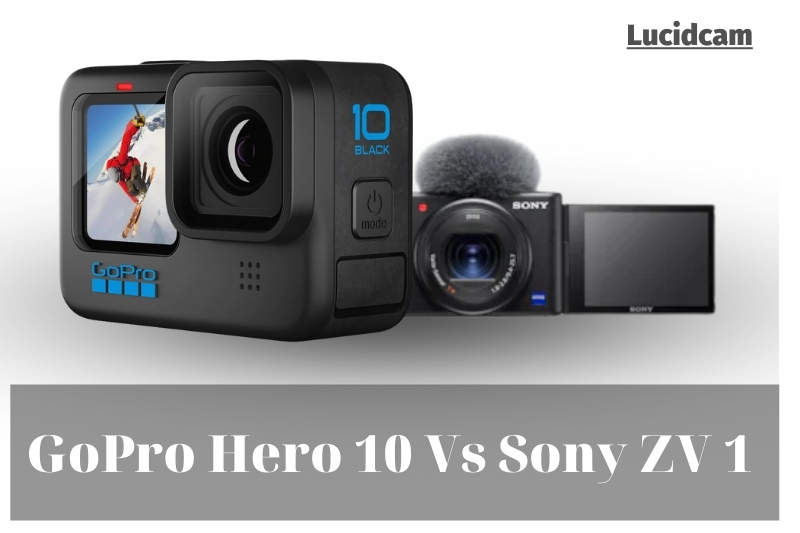GoPro’s newest camera, the Hero 10, offers a number of improvements over its predecessor. One of the most notable is the addition of stabilization, which should help keep your shots steady. The Hero 10 also gets a new sensor and a new processor, which should improve image quality. But how does it stack up against Sony’s new point-and-shoot camera, the ZV-1?
In this blog, we will discuss the difference between GoPro Hero 10 vs Sony ZV-1
Table of Contents
Sony ZV-1
Pros
- Class-leading autofocus
- Bright lens for beautiful video bokeh
- Hotshoe and the 3.5mm mic port
- A side-flipping screen is ideal for video
- Fits in your pocket
Cons
- Average video stabilization
- The touchscreen still very limited
- Micro USB instead of USB-C
- Poor Battery
GoPro Hero 10
Pros
- UI is speedier than ever thanks to the GP2 processor
- Increased frame rates across the board
- Stabilization using HyperSmooth 4.0 is a technological wonder.
- Interesting footage
Cons
- Low-light challenges
- The pricing is extremely high.
GoPro Hero 10 Vs Sony ZV 1
Design
Sony ZV-1
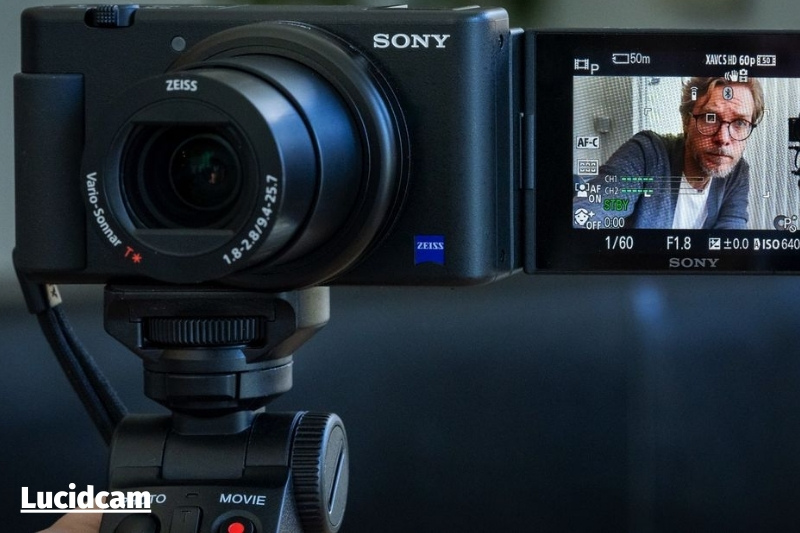
- Side-flipping LCD Screen is Ideal for Video
- It’s easy to attach an external microphone using the hot shoe or 3.5mm port
- The RX100 series viewfinder and lens control rings are missing
The Sony ZV-1 is a Sony RX100 Mark V, but it’s been redesigned to be more useful for YouTubers. Although the final result isn’t perfect, it fixes most of our criticisms of the Mark V in regard to video shooting.
It’s also one of few compact cameras designed specifically for video, along with the Canon G7X Mark III.
The good stuff. A side-hinged, articulating touchscreen is the best feature. Because it doesn’t take up any space on the camera’s top or bottom, this screen is more suitable for video shooting than a tilting model.
It can also be turned 180 degrees to face forwards. This allows YouTube channel owners to frame their shots with no need for a second person behind the camera.
Unfortunately, Sony’s touchscreen functionality remains limited. The touchscreen functionality of Sony’s camera is limited.
You can tap on the screen to focus on video, but you cannot navigate menus or zoom in on photos. This is a shame considering the camera was designed for those who want to upgrade from smartphones. However, there is still room for a hot shoe on the top of the camera.
The electronic viewfinder on Sony’s RX100 series is now replaced by this hot shoe. For stills-focused cameras, losing an EVF is a major deal. However, it’s worth considering if you require a versatile camera that can do both video and photos.
It makes sense for a ZV-1 vlogging camera, as its target audience will primarily use the screen as a viewfinder. This also helps to lower the ZV-1’s price, although not as much as we hoped.
It’s a great bonus to be able to plug-in accessories such as external microphones or LED lights into the hot shoe.
The Sony RX100 VII required an external bracket to mount it. But the ZV-1 is a different story. This brings us to another ZV-1 bonus: a 3.5mm microphone input.
It doesn’t make sense to shoot a great video if the audio isn’t there. A 3.5mm port is crucial for vlogging cameras.
The Sony ZV-1 actually has an upgraded built-in microphone. It is a three-directional capsule microphone with left, center, and right channels.
Sony also includes a ‘dead cat’ windshield along with the ZV-1. This plugs into your hot shoe to reduce wind noise while outdoors. As we’ll see, an external microphone still outperforms any built-in counterpart, so the 3.5mm port is a vital addition.
A micro-USB port located below the mic port is slightly less appreciated. Although it is not a major feature, we expect all new cameras will have USB-C ports. This allows for fast charging and convenience.
For example, the Fujifilm X-T4 comes with a USB-C adaptor for headphones that allows you to monitor the sound of your recordings. This is not possible on the ZV-1. The Sony ZV-1 can be charged while you use the camera.
Two other design features are unique to the Sony ZV-1 that you won’t find on any RX100 VII or any of its predecessors. The other is a small grip for your hand. Although this does not change the ZV-1’s handling, many RX100-series users have made it a feature of their cameras by adding third-party accessories.
Finally, the video recording button on a Sony camera is now larger than the still shutter button.
Although they might not seem important, these are very significant. They make the ZV-1 a video-first camera, but can also take stills. The ZV-1 is the perfect pocketable tool for YouTubers and vloggers, with features such as an EVF, lens control ring and hot shoe.
GoPro Hero 10
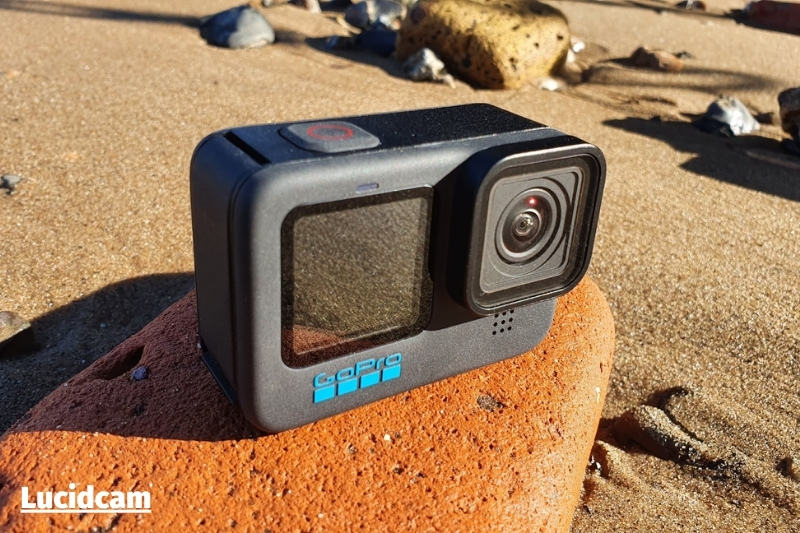
- Nearly identical to the Hero 9
- It is slightly lighter than its predecessor
- Compatible with Hero 9 accessories
The Hero 9 owners may have been a bit confused when the Hero 10 was revealed. Except for the GoPro logo changing to bright blue, very little can be used to distinguish the model last year from its predecessor. But, if you dig deeper, you’ll find some subtle changes.
The lens for Hero 10 is made from a hydrophobic material, which allows it to work more efficiently underwater and is also scratch-resistant and less susceptible to ghosting.
GoPro Hero 10 Black’s shutter button
The camera is also slightly lighter than the Hero 9 (down from 158g and 153g), something you would only notice if you were upgrading. If you are upgrading from the Hero 9, then you can rest assured that all accessories will work fine with the Hero 10.
The design is still very similar, and I like the fact that it supports GoPro mods backward. The Hero 10’s large rear-facing display, as well as the handy second screen at the front, are both easy to use.
While I appreciate the additional features of a modular camera like the Insta360 One RS, I find the GoPro style much more intuitive for capturing the moment.
In short, there is a significant difference in design between the Sony ZV-1 and the GoPro Hero 10. The Sony ZV-1 is substantially smaller and lighter, making it perfect for travel and daily usage.
The GoPro Hero 10 is bigger and heavier, making it more suitable for action and adventure activities. Both cameras have their own unique strengths and weaknesses, so which one is the better choice really depends on your needs and preferences.
Features
Sony ZV-1

- Two new shortcut buttons are available for beginners to vlogging
- For more advanced vloggers, picture profiles allow for editing flexibility
- Fun and useful are slow-motion modes
What other video-friendly goodies does the Sony ZV-1 offer beyond its excellent autofocus? It’s a lot, which can be a problem for usability.
Sony’s camera menus have a reputation for being as intuitive as a book on hieroglyphics.
These settings include two new default settings that the camera’s custom buttons can use. The ‘Bokeh switch’ is the first. This will immediately switch to a wide aperture to give your footage a blurred background. This shortcut is based solely on traditional optics and does not work in the same way as smartphone portrait modes.
The second and possibly more useful custom button is called “Product showcase“, which is specifically designed for YouTubers who are experts in reviewing products.
This doesn’t do any more than what you can do with the settings. However, pressing this immediately turns off SteadyShot stability (making a tripod essential for this model) and Face and Eye Priority AF.
When you hold a product in front of the camera, it will focus on that object instead of prioritizing your face. This is possible because of the ZV-1’s speedy autofocus.
These feel like bolted-on solutions. The ZV-1 feels a lot like an RX100 compact camera. It also feels dated when compared to touchscreen apps like FilmicPro. Expect to spend a lot of time looking through the ZV-1’s menus and creating custom menus.
This is partially due to the ZV-1’s many features. Many of these features are aimed at advanced video photographers. This gives the ZV-1 incredible depth for such a small camera.
The built-in ND filter is back, which is a welcome addition. Although it was removed from the RX100 cameras, this filter is still essential to capture smooth movement on bright days.
It allows you to use slower shutter speeds and doesn’t require stopping the lens down.
If you dig a little deeper, you’ll find compositional aids such as focus peaking or zebra patterns. You also have all of Sony’s picture profiles (S-Log2, SLog3 and Hybrid Log-Gamma) for those who want to color-grade their footage to get the maximum amount of dynamic range.
What about the more common settings like frame rate and resolution? The ZV-1 can capture 4K at a maximum of 30p, just like the RX100 Mark VII.
Although it is disappointing that the ZV-1 doesn’t offer a 4K/60p option, 4K footage can be captured at least by oversampling rather than pixel binning. The former is a superior way to capture 4K images from the 20.1MP sensor and helps avoid jagged edges.
There are also faster frame rates if you’re comfortable shooting in 1080p. Sony also offers impressive super slow-mo options that go up to an amazing 960fps.
There is a significant quality loss in this area, which we will discuss with you along with ZV-1’s stabilization, battery life, and other performance issues.
GoPro hero 10
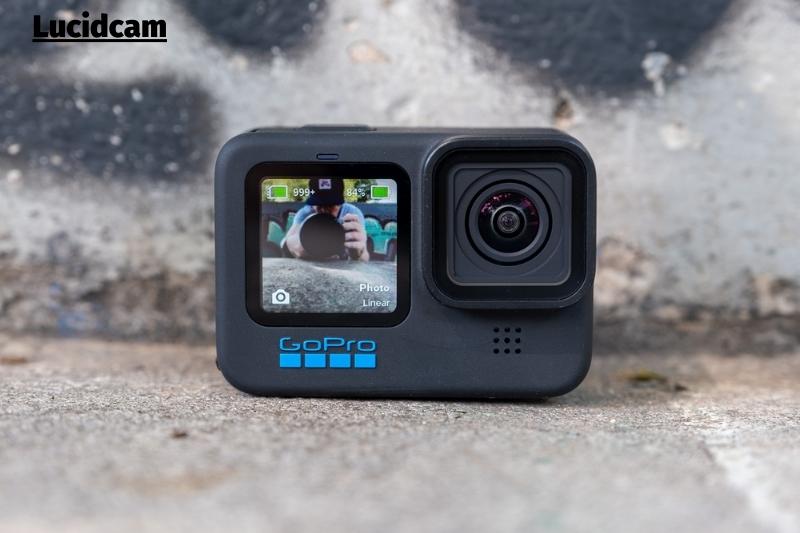
The front of the camera has the lens, microphone, and a front-facing LCD display measuring 25 x 25mm.
New coatings and scratch resistance have been added to the lens. They also repel water and minimize ghosting. GoPro’s ultra-wide-angle Max Lens Mod is compatible with the lens housing.
The large touch-sensitive 50x33mm display is the focal point of the rear camera. There are physical buttons on the top edge for shutter and power. A second microphone is located beneath the power button.
It is designed to allow for quick water drainage during diving. A watertight hatch is located on the opposite side. It houses the micro-SD card slot, the battery and the USB-C port. The Hero 9 camera uses the same batteries and can be powered over a USB.
The camera has dedicated modes for taking photos and videos and creating time-lapses. Each mode can be customized with customizable interfaces.
You can also use the built-in presets to create slow-motion photos, night lapses and TimeWarp hyper-lapse.
You can adjust the camera’s crop and distortion using digital lenses, as with all modern GoPros.
There are options from 16mm at one end to 27mm at another, but SuperView is limited to resolutions below 4K. You can also engage HyperSmooth stabilization to get an additional crop.
GoPro’s Quik app can be used to control and edit your Hero 10 Black wirelessly. It also supports a direct USB connection for faster file transfers.
Image and Video Quality
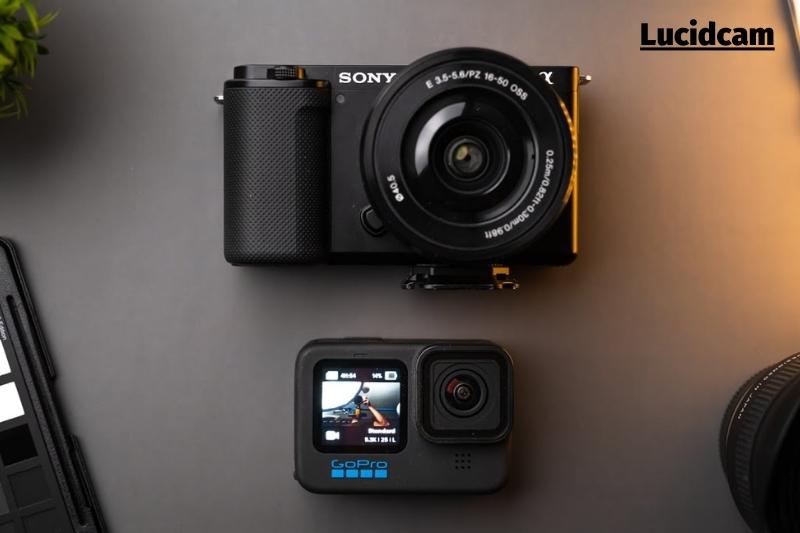
Sony ZV-1
- Crisp, detailed 4K/30p video
- The default skin smoothing can be turned off, but it is sometimes a bit too much.
- Strong stills performance but no viewfinder
The ZV-1, like the Sony RX100, oversamples video footage and then downsamples it to 4K. This produces sharper results than other techniques such as pixel binning. You can see the difference in the 4K footage. It is crisp and detailed and does not crop unless you are using an ‘Active’ stabilizer.
The ZV-1 does not have a 4K/60p option. This would allow you to slow down 4K clips with no loss of quality. It’s not a huge miss.
The 4K/30p mode is impressive with its lack rolling shutter. This is a common side effect of CMOS sensors and can sometimes cause skewed lines when panning fast.
Although the ZV-1 is able to move smoothly in bright conditions thanks to its 1-inch sensor, it struggles in low light.
Picture profiles such as S-Log2 can be used to get more detail from high-contrast scenes. However, you will need to be familiar with color grading before you attempt this.
Sony has focused on human exposure and color quality with the ZV-1. Sony claims that it has developed an “optimized color algorithm” based on feedback from all over the globe. This ensures natural skin tones, no matter where you are located.
It is also said that the ZV-1 uses its face recognition technology to determine exposure readings to ensure that the vlogger’s face remains bright and well-exposed in all lighting conditions.
We found it to work well, but we have not yet been able to test it on different faces. We did make some adjustments to the ZV-1’s skin-smoothing effect. This is quite strong by default, so we would recommend turning it down or switching it off completely.
Sony tried to make the ZV-1’s skin-smoothing effect more natural than other similar smartphone modes, but we still find it a little too artificial.
The ZV-1 can also be used as a stills camera, even though it is geared towards vlogging. It lacks a viewfinder and lens control ring, so it isn’t as good as its RX100 stablemates.
However, the ZV-1 still has great quality if you are looking to capture some Instagram-worthy stills that will complement your YouTube videos.
Images are rich in detail. Raw images can also bring out more details from shadows and highlights. The noise is controlled up to ISO 800. Image quality drops below ISO 6400.
It’s possible to argue that smartphones today are at least equal to the ZV-1 in stills photography because of their computational smarts. The ZV-1’s bright lens, high-speed shooting modes and excellent quality make it an ideal backup tool for taking action shots and portraits.
GoPro Hero 10
- For almost all modes of shooting, higher refresh rates are required
- Time Warp and other features continue to be great features.
- Low-light performance can be a downer
The Hero 10’s capture quality is not up to par, so all the improvements made by the GP2 processor would be insignificant. GoPro continues to win in this area.
The Hero 10 can capture stunning footage even when shooting in daylight. It can capture stunning detail and color without ever going over the saturation line, much like the iPhone.
Autofocus is also excellent and ensures that your face is always prioritized in all shots. The Hero 10 can adapt quickly to new environments, such as underwater scenes, to make it almost instantaneous.
The Hero 10’s maximum frame rate is 5.3K. This is just like Hero 10. The Hero 10 can now capture 5.3K at 60fps, 4.7K at 120fps, and 2.7K @ 240fps. These improvements are far more appealing than the 8K, which, let’s be honest, has a long way before it becomes the norm.
These higher frame rates are a boon to those who want to capture action shots at higher resolutions. Also, the camera’s megapixel count has increased from 20 to 23 MP. The Hero 10’s stills look great, just like video capture.
In particular, with wide-angle shots, Hero 10 has been able to recreate the same sense of scope as I experienced on a recent visit to the Irish countryside.
Night-time photography was the one area in which the stills did not live up to their hype. The Hero 10 has a Night mode, but the camera couldn’t produce the same quality images as daytime. Unfortunately, this isn’t a problem that’s only for stills.
Low-light shooting removed much of the GoPro’s shine from the final footage. This led to a lot more detail being lost in the mix.
It’s a shame because the Hero 10 is no longer a reliable camera that can be used at all times of the day. For night shots, you might consider a different camera if you are planning a camping trip. The iPhone 13 is not as easy.
GoPro Quik is still a top-of-the-line app, especially in terms of its simplicity and ability to allow even novice filmmakers to create stunning collages of footage after every shoot.
In just five minutes, I was able to edit and create a shareable video using a day’s worth of footage. This is a significant improvement over other apps.
Last but not least, the Hero 10’s mic is a big fan of mine. It picked up every word I said, even though it could use some voice isolation in post. Later, on London’s bustling South Bank, Hero 10 was able to pick up my voice despite the background of tourists and construction sites.
Battery life
The battery life isn’t very good. The ZV-1 is powered by the NP-BX1 slim battery. The ZV-1 can record approximately 260 photos or 45 minutes per charge. The GoPro Hero10 Black has the same 1720mAh battery as the GoPro Hero9, which is different than all other GoPro batteries.
GoPro does not make any claims about the Hero10’s battery life. The Hero10 will last 1.5 to 2 hours, depending on how you set it up.
Conclusion
The GoPro Hero 10 is the clear winner when it comes to video quality. The Sony ZV-1 produces great video, but it doesn’t have the same level of detail and clarity as to the Hero 10. The Hero 10 also has better image stabilization, which is especially important for action cameras.
Please share this post if you found it helpful so that others might see its contents as well! Thank you for reading!
